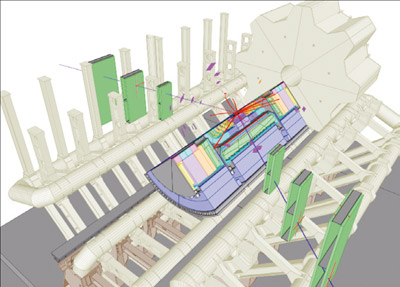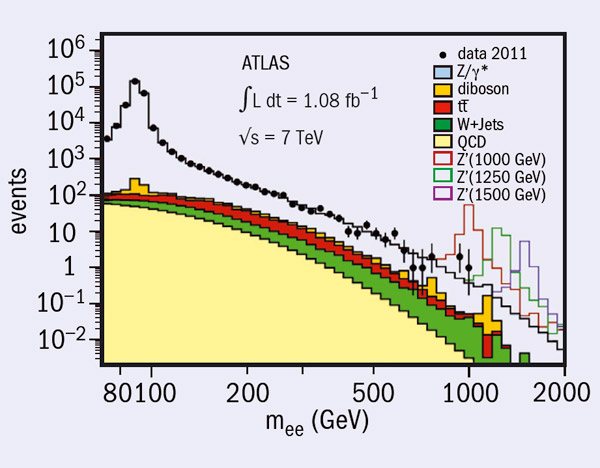The ATLAS Collaboration has published its latest search for neutral resonances decaying to pairs of leptons, either electrons or muons.

Searches for dilepton resonances have a history of discoveries, from the J/ψ and Υ to the Z boson. Now new neutral gauge bosons, Z’, which would appear as resonances, are predicted by a number of theories. They are the mediators of new forces that allow the unification of all fundamental forces at some very large energy scale. Dilepton resonances are also predicted as gravitons in models of extra-dimensional gravity.
The analysis by ATLAS used a data sample corresponding to an integrated luminosity of 1.1 fb–1. The sensitivity to new physics extends to 1.8 TeV, similar to that of recent preliminary results from CMS and far beyond the limits achieved at lower-energy accelerators. The observed dilepton mass distributions (for example, the di-electron distribution of figure 2) are in good agreement with the spectrum predicted by the Standard Model including higher-order QCD and electroweak corrections.

The search technique employed by ATLAS involves the comparison of the dilepton mass distribution with the predicted spectrum over the entire high-mass range. The prediction includes a series of hypothetical resonance line-shapes with different masses and couplings. The dominant sources of systematic uncertainty are of a theoretical nature, arising from the calculations of the production rates.
The ATLAS detector will measure the mass of any resonance observed quite accurately. The liquid argon calorimeter provides a linear and stable response for electrons up to the highest energy, and the combination of the inner detector and the muon spectrometer provides muon measurement at the highest momenta. ATLAS will also measure the cross-section, couplings, spin and interference properties of a resonance.
Work is ongoing to increase the lepton acceptance further, and ATLAS will extend the kinematic reach of these exciting measurements with much larger datasets in 2011–2012.
Further reading
ATLAS collaboration 2011 arXiv:1108.1582, accepted for publication by Phys.Rev.Lett.
CMS collaboration 2011 CMS-PAS-EXO-11-019.
For these results and more, see https://twiki.cern.ch/twiki/bin/view/AtlasPublic.







